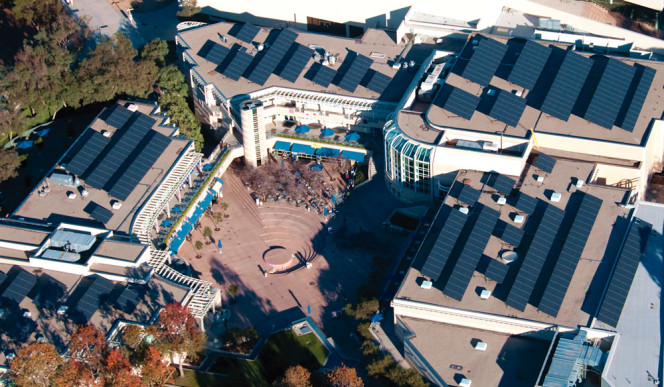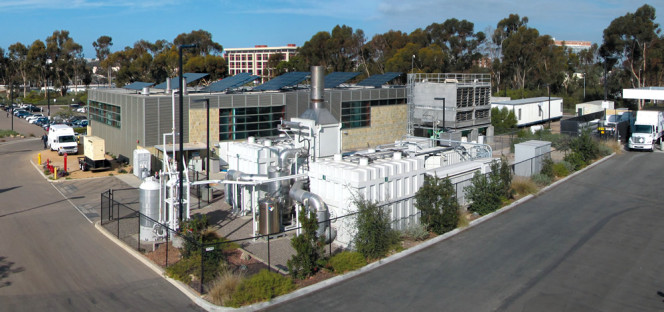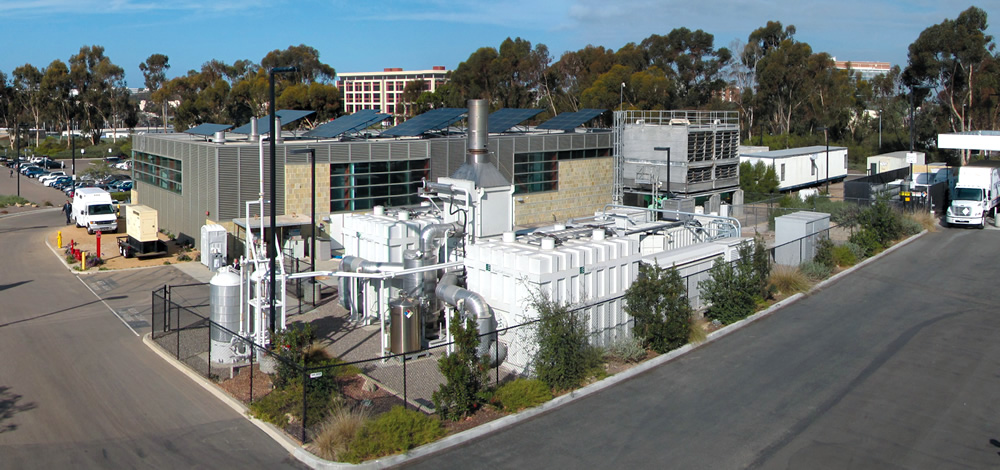The University of California San Diego’s microgrid produces 92 percent of its annual electricity load and 95 percent of its heating and cooling load. A fuel cell powered by directed biogas is a cornerstone of the operation.
Marsha W. Johnston
BioCycle July 2014

As of the fourth quarter of 2013, nearly 100 percent of all architecturally suitable campus building rooftops at UCSD are photovoltaic-equipped. Photo courtesy of University of California San Diego
Perched on the wind-sculpted bluffs above the Pacific Ocean, the University of California San Diego (UCSD) is one of the world’s leading research universities, with an average R&D budget of $1 billion in each of the last three years. Research includes over 50 years of investigating climate change at UCSD’s Scripps Institution of Oceanography, making it no surprise that the university operates one of the world’s most advanced, low emission microgrids.
“There is definitely a movement toward microgrids for communities, industries and military bases that are looking to increase three things: reliability, survivability and resiliency when natural or manmade disaster occurs,” says Byron Washom, Director of Strategic Energy for UCSD’s campus. This 42-megawatt microgrid, however, is more than just a backup in case of disaster. It self-generates 92 percent of UCSD’s annual electricity load and 95 percent of its heating and cooling load, which is no mean feat, as UCSD has 11.6 million square feet of buildings. Six million of the total square feet have been added in the last 10 years, an area equal to 60 percent of the Pentagon, Washom adds.
Washom likens the operation of the university’s state-of-the-art microgrid to a symphony, where many instruments must seamlessly integrate a multitude of notes into a beautiful serenade, and where each must know how and when to cede performance to the most optimally placed instrument. “Within microgrid development, gas turbines or fuel cells are an essential cornerstone in order to firm up the generation reliability,” he explains. “And of the two fuel choices for those, natural gas and biofuels, biogas fuel is by far the best environmental choice. [With biogas] you avoid the intermittency issue. You firm up your reliability of supply.”
Directed Biogas
Biogas is a stellar feature of UCSD’s microgrid, and marks a first for the state. The biogas is generated by the Point Loma wastewater treatment plant, conditioned to natural gas pipeline quality and injected into the pipeline as renewable natural gas. The UCSD fuel cell utilizes an equivalent amount of fossil natural gas. This arrangement is referred to as “directed biogas” (see “Directed Biogas To Power Fuel Cells,” June 2011). “The Point Loma wastewater treatment plant was flaring excess methane, so we entered into a partnership and raised funding for a purification plant,” says Washom. “It’s the first time in California someone has taken surplus methane from a wastewater treatment plant and injected it into an SDG&E (San Diego Gas & Electric) pipeline based on industry standards, which I can guarantee were written never to be met. But we did!”
Kenneth Frisbie, managing director of BioFuels Energy LLC, the university’s partner in the project, concurs with Washom that they were the first to meet California’s Rule 30 requirement for purifying waste methane to meet the 990 BTU standard to inject it into a utility pipeline. The Point Loma plant was flaring 1.1 million cubic feet per day.
Frisbie says they use an Air Liquide biogas purification system to comply with Rule 30. In addition to purifying the gas, other requirements for interconnection included a study to determine if the nearest pipeline had enough capacity to take the gas. “We were lucky to be able to interconnect into that pipeline,” says Frisbie. “No capacity increases needed to be done.” It cost $1.6 million to determine that BioFuels could connect to a pipeline situated approximately 1,000 feet from the treatment plant.
Washom acknowledges the pivotal role the university played. “UCSD was the philanthropic agent for the orchestra. Had we not been the financial partner to take the directed biogas, it would not have occurred. Someone could have stepped forward and said if you can purify [the gas] and inject it into the pipeline and get renewable credits, we will be happy to use it in our turbine. But we said, `Not only do we want the directed biogas, but we want to use it in a fuel cell because a fuel cell converts to electricity without combustion, and gives ultra low emissions.’”
The result: UCSD campus has the world’s largest fuel cell — 2.8 MW — that uses wastewater treatment plant methane. “It’s a swap,” says Washom. “People in Point Loma are locally using our methane, and we’re using their natural gas coming from the north and headed in their direction!”

The 2.8 MW fuel cell covers an area the size of a tennis court. Combined with an absorption chiller, it will reach 68 percent efficiency.
Photo courtesy of University of California San Diego
He notes that the size and efficiency of the fuel cell is stunning. Covering an area the size of a tennis court and combined with an absorption chiller, it will reach 68 percent efficiency (approximately 48% electricity and 20% chilling capacity). “To put that in perspective, our central utility plant, 10 times the size, won an EPA EnergyStar award in 2010 by reaching 66 percent efficiency, and it was only one of three to get the award!,” explains Washom. “We have reduced the size of the power plant by an order of magnitude and simultaneously boosted efficiency into the same stratosphere as the best in class. Very seldom do you reduce something by an order of magnitude in size and still maintain efficiency.” He adds that the pollutants coming out of UCSD’s fuel cell are barely measurable.
Other Orchestra Members
In addition, the UCSD microgrid orchestra features the following instruments:
• 2 MW of photovoltaic modules on-campus, and 1 MW off-campus
• Two concentrating photovoltaic (CPV) research demonstration systems. To produce a total of approximately 30kw, the 220-square-foot CPV panel mounted on a movable platform automatically tracks the sun as it crosses the daytime sky and concentrates sunlight onto hundreds of electricity-producing solar cells, each smaller than a shirt button
• An EPA Star Award 27-MW combined cooling heat and power plant and a 4-million-gallon thermal storage system
• A 69 kilovolt (kV) substation, ninety-six 12 kV underground feeder circuits and four 12kV distribution substations to properly distribute the microgrid’s electricity where it is needed throughout the 1200-acre campus
“As we’re growing, we are meeting all of the new demand first with energy efficiency on older buildings, and with the amount we are self-generating, by bringing on the fuel cell for base load and PV for daytime load,” says Washom, adding that the 2.8 MW of fuel cell and 2 MW of PV were in part a response to the need for additional generation. The fuel cell provides 8 percent of the university’s current load, and, as of the fourth quarter of 2013, nearly 100 percent of all architecturally suitable campus building rooftops are PV-equipped.
To increase the value of its PV, UCSD is perfecting the science of day-ahead solar forecasting to predict when the PV panels will produce the most energy. By studying collected weather data, researchers forecast PV performance for California-specific meteorological events, such as winter frontal system marine layer clouds and Tule fog.
“The degree of certainty is what they are constantly working on,” explains Washom. “In California, our complexity comes from the marine fog layer, where all of the PV capacity is almost at zero, then suddenly it burns off and the local utility gets a huge in-rush [of PV-generated electricity]. So predicting when the marine layer will burn off is a big issue. Clouds — their pattern, movement, height and velocity — are considered the most chaotic phenomena in nature, so the challenge to be able to predict when they will be at a certain place at a certain time gives an appreciation of what we’re doing.” Researchers have refined both the 24-hour and 30-minute solar forecast to be 40 percent more accurate to the amount of sunlight that will be utilized by individual PV modules, he adds.
To further increase the value of the microgrid, Washom is developing the largest, most diversified portfolio of energy storage technologies of any university in the world. The storage systems serve to smooth over the intermittent nature of solar generation, storing the power for targeted use, particularly for electric vehicle (EV) charging, as well as storing cheap grid energy for use during expensive on-peak hours.
The storage systems integrated with UCSD’s PV installations include:
• An operational 10 kW Sunverge
100 kW/300 kWh ZBB Flow Battery, targeted at demand reduction (in start-up/commissioning phase)
• 28 kW Maxwell Labs for ultracapacitors integrated with the CPV system (in start-up/commissioning phase)
• 730 kW/1460 kWh Self-Generation Incentive Program PV Integrated at five off-campus sites (in planning)
The microgrid’s largest storage system, currently under construction, is a 2.5 MW/5 MWh Advanced Energy Storage, lithium-ion battery. It is the only storage system not integrated with PV, as it works with the microgrid’s 2.8 MW fuel cell to provide the economic advantages of permanent load shifting. With permanent load shifting, the university fires up the fuel cell at night, when the natural gas-generated SDG&E grid’s energy is 6 cents/ kWh, and charges the batteries. It then uses that battery energy during the day to avoid paying double that price for SDG&E grid energy.
Taken together, UCSD saves more than $800,000/ month from its microgrid, versus being a direct access customer importing from the SDG&E grid. Working with energy conglomerate RWE and Daimler Benz Smart Cars, UCSD has grown its installation of EV charging stations from 26 to 56 that meet 2017 standards for a high-level IQ charger and Smart car. Supported by the microgrid, Washom calls it the largest portfolio of EV charging stations at a university in the world.
The microgrid has won many awards, including from the U.S. Environmental Protection Agency and the state of California, and rave reviews from publications ranging from Forbes to Sierra to Smart Grid Today. “We show the art of the possible, and with every single project we have on campus, the incentives we use are available to every commercial, industrial and military installation in California,” Washom declares, adding that if UCSD can build such an advanced microgrid despite the huge budgetary problems faced by the UC system in the last several years, anyone can.
Marsha Johnston is with Earth Steward Associates, and a Contributing Writer to BioCycle.













